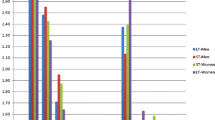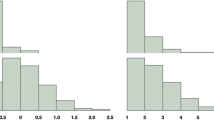Abstract
Male sexual orientation is strongly associated with childhood sex-typed behavior, but there are also marked within-orientation differences. Gay men show increased variance compared to heterosexual men on retrospective measures of childhood sex-typed behavior. Individual differences among gay men for their degree of sex-typed behavior may have important implications. However, there has been little attention given to the reliability or validity of retrospective measures of such differences that are most common. Gay men and their mothers completed questionnaires assessing the men's sex-typicality during childhood. Results of structural modeling analyses found that mothers' and sons' reports were significantly associated, both regarding the general level of sex-typed behavior and the specific behaviors, supporting the validity of retrospectively measured individual differences for those characteristics.
Similar content being viewed by others
References
Bailey, J. M., and Pillard, R. C. (1991). A genetic study of male sexual orientation.Arch. Gen. Psychiat. 48: 1089–1096.
Bailey, J. M., and Zucker, K. J. (1995). Childhood Sex-typed behavior and sexual orientation: A conceptual analysis and quantitative review.Dev. Psychol. 31: 43–55.
Bailey, J. M., Miller, J. S., and Willerman, L. (1993). Maternally-rated childhood gender nonconformity in homosexuals and heterosexuals.Arch. Sex. Behav. 22: 461–470.
Bell, A. P., Weinberg, M. S., and Hammersmith, S. K. (1981).Sexual Preference: Its Development in Men and Women Indiana University Press, Bloomington.
Bieber, I., Dain, H. J., Dince, P. R., Drellich, M. G., Grand, H. G., Gundlach, R. H., Kremer, M. W., Rifkin, A. H., Wilbur, C. B., and Bieber, T. B. (1962).Homosexuality: A Psychoanalytic Study Basic Books, New York.
Bollen, K. A. (1989).Structural Equations with Latent Variables Wiley, New York.
Dörner, G., Docke., F. Gotz, F., Rohde, W., Stahl, F., and Tonjes, R. (1987). Sexual differentiation of gonadotrophin secretion, sexual orientation and gender role behavior.J. Steroid Biochem 27: 1081–1087.
Freund, K., and Blanchard, R. (1983). Is the distant relationship of fathers and homosexual sons related to the sons' erotic preference for male partners, to the sons' atypical gender identity, or to both? In Ross, M. W. (ed.),Homosexuality and Social Sex Roles, Haworth, New York, pp. 7–25.
Gerbing, D. W., and Anderson, J. C. (1993). Monte Carlo evaluations of goodness-of-fit indices for structural equation models. In Bollen, K. A., and Long, J. S. (eds.),Testing Structural Equation Models Sage, Newbury Park, CA.
Green, R. (1987).The “Sissy Boy Syndrome” and the Development of Homosexuality Yale University Press, New Haven, CT.
Harry, J. (1983a). Defeminization and adult psychological well-being among male homosexuals.Arch. Sex. Behav. 12: 1–19.
Harry, J. (1983b). Parasuicide, gender, and gender deviance.J. Health Soc. Behav. 24: 350–361.
Johnson, R. A., and Wichern, D. W. (1992).Applied Multivariate Statistical Analysis 3rd ed., Prentice-Hall, Englewood Cliffs, NJ.
Jöreskog, K. G., and Sörbom, D. (1989).LISREL 7: A Guide to the Program and Applications 2nd ed., SPSS, Inc., Chicago, IL.
Meyer-Bahlburg, H. F. L. (1993). Psychobiologic research on homosexuality.Child Adolescent Psychiat. Clin. N. Am. 2: 489–500.
Meyer-Bahlburg, H. F. L., Feldman, J. F., and Ehrhardt, A. A. (1985). Questionnaires for the assessment of atypical gender role behavior: A methodological study.J. Am. Acad. Child Psychiat. 24: 695–701.
Ross, M. W. (1980). Retrospective distortion in homosexual research.Arch. Sex. Behav. 9: 523–531.
Weinrich, J. D., Grant, I., Jacobson, D. L., Robinson, S. R., McCutchan, J. A., and The HNRC Group. (1992). Effects of recalled childhood gender nonconformity on adult genitoerotic role and AIDS exposure.Arch. Sex. Behav. 21: 559–586.
Whitham, F. L. (1977). Childhood indicators of male homosexuality.Arch. Sex. Behav. 6: 89–96.
Zuger, B. (1984). Early effeminate behavior in boys: Outcome and significance for homosexuality.J. Nerv. Ment. Dis. 172: 90–97.
Author information
Authors and Affiliations
Rights and permissions
About this article
Cite this article
Bailey, J.M., Nothnagel, J. & Wolfe, M. Retrospectively measured individual differences in childhood sex-typed behavior among gay men: Correspondence between self- and maternal reports. Arch Sex Behav 24, 613–622 (1995). https://doi.org/10.1007/BF01542183
Issue Date:
DOI: https://doi.org/10.1007/BF01542183




